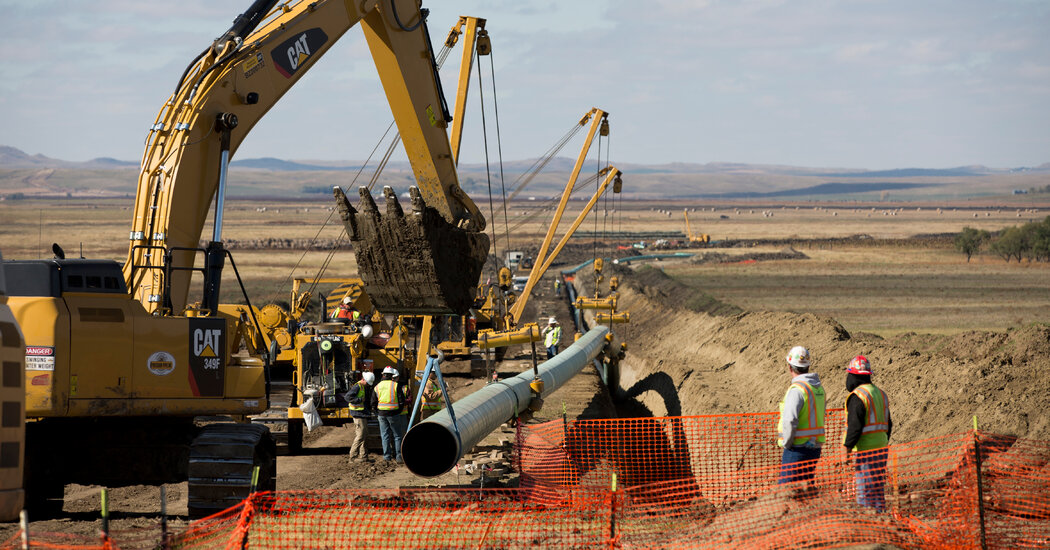Lawyers for the pipeline company Energy Transfer and Greenpeace fired their opening salvos in a North Dakota courtroom Wednesday morning in a civil trial that could bankrupt the storied environmental group.
The suit revolves around the role Greenpeace played in massive protests against construction of the Dakota Access Pipeline nearly a decade ago. The pipeline, which carries crude oil from North Dakota across several states to a transfer point in Illinois, was delayed for months in 2016 and 2017 amid lawsuits and protests.
The trial commenced on Wednesday with opening arguments in a quiet county courthouse in Mandan, N.D. Greenpeace says Energy Transfer, which built the Dakota Access Pipeline, is seeking $300 million in damages.
Energy Transfer, one of the largest pipeline firms in the country, accused Greenpeace of inciting unrest that cost it millions of dollars in lost financing, construction delays, and security and public-relations expenses. Trey Cox, its lead lawyer, told the nine-person jury that his team would prove that Greenpeace had “planned, organized and funded” unlawful protests. He called the trial a “day of reckoning.”
Everett Jack Jr., the lead lawyer for Greenpeace, gave a detailed timeline to rebut aspects of that account, saying Greenpeace played a minor role in the demonstrations, which drew an estimated 100,000 people to the rural area.
The protests originated with the Standing Rock Sioux Tribe, which argued that a portion of the pipeline under Lake Oahe, on federal land near its reservation, endangered the water supply and sacred sites on its ancestral territory. The tribe began protesting in spring 2016 and filed lawsuits aimed at stopping the pipeline’s operations. The Dakota Access Pipeline has been operating since 2017, though final approval is pending.
Conflicts between protesters, law enforcement and private security forces began in August 2016, the lawyer for Greenpeace said, and the numbers of demonstrators swelled. Mr. Jack said the protests had already escalated into dangerous confrontations before Greenpeace was involved.
He pointed to Sept. 3, 2016, when he said private security released dogs on people protesting that Energy Transfer was bulldozing in an area where a tribal leader had asserted there were cultural artifacts. It was a confrontation that drew media attention and caused more people to join the protests, but at the time no one from Greenpeace had arrived there, Mr. Jack said.
He said two staff members had arrived two days after that confrontation, in order to bring a solar truck to provide electricity. Mr. Jack said Greenpeace was committed to nonviolence and got involved not to incite unrest, but rather to help “de-escalate” and provide aid like tents and training. He told the jury there was no evidence to support the contention that Greenpeace was responsible for the protests.
In his opening arguments for Energy Transfer, Mr. Cox cited Greenpeace’s internal emails and publications, including a letter to international lenders signed by Greenpeace and other groups. That letter, written by BankTrack, a Dutch organization that works on environmental causes, called on Energy Transfer’s lenders to halt loans for the Dakota Access project. Mr. Cox said the campaign had led the project to lose lenders and refinance at higher rates.
Greenpeace said there was no evidence that the banks had made decisions based on the letter, which was signed by more than 500 groups.
During the two-day jury selection that started on Monday, numerous prospective jurors indicated that they or their relatives had ties to the oil and gas industry or to local law enforcement officials who had been involved in responding to the protests. That was expected given the prominence of the oil and gas industry in the region, and could give Energy Transfer an advantage in the trial.
The selected jurors consisted of eight women and three men, including two alternates.
Lawyers for two other entities named in the lawsuit, Greenpeace International, based in the Netherlands, and Greenpeace Fund, based in Washington, also made statements in court. They said their organizations were separate and had not been involved with the protests.
The trial is scheduled to last five weeks.


